Experimental Evaluation and Theoretical Optimization of an Indirect Solar Dryer with Forced Ventilation under Tropical Climate by an Inverse Artificial Neural Network
Abstract
:1. Introduction
2. Materials and Methods
2.1. Description of the Experimental System
2.2. Computational Methodology
2.2.1. Experimental Database Construction
2.2.2. Artificial Neural Network Modeling
2.2.3. Optimization Approach by Inverse ANN
3. Results and Discussion
3.1. Experimental Evaluation of the Solar Dryer
3.1.1. Taro (Colocasia esculenta)
3.1.2. Plantain
3.2. Artificial Neural Network Model
3.3. Garson Sensitivity Analysis
3.4. Optimal Operation Conditions
4. Conclusions
Author Contributions
Funding
Institutional Review Board Statement
Informed Consent Statement
Data Availability Statement
Acknowledgments
Conflicts of Interest
Appendix A
| Line | Type Algorithm | Simulation Parameters | |
|---|---|---|---|
| Genetic Algorithm | Parameter | Value | |
| 1 | Initial population Pobn = 100 | Generations (Genn) | 250 |
| 2 | for g = 1 to Genn = 250 do | Population (Pobn) | 100 |
| 3 | for i = 1 to Pobn do | Mutation | Uniform |
| 4 | Individual fitness i = {Tout-sim − Tout-exp} | Crossover | Uniform |
| 5 | end for | Selection | random |
| 6 | move the best fitness to population g + 1 | ||
| 7 | for i = 2 to Pobn do | ||
| 8 | Selection of two individuals | ||
| 9 | Apply crossover to create two new individuals | ||
| 10 | Apply mutation to the remaining population | ||
| 11 | end for | ||
| 12 | move new individual, mutate and crossed to population (g + 1) | ||
| 13 | end for | ||
| Line | Type Algorithm | Simulation Parameters | |
|---|---|---|---|
| Particle Swarm | Parameter | Value | |
| 1 | Initialization for particle 1 to N Initialize the position xi (0) ∀ i ∈ 1: N Initialize particle best position to initial position pi (0) = xi (0) Calculate the fitness of each particle and, if ƒ(Xj(0)) ≥ ƒ(Xi(0)) ∀ i ≠ j, initialize the global best as g = xj(0) | Steps (ns) | 100 |
| 2 | while stopping criteria is not reached | Particles (N) | 250 |
| 3 | Update velocity for particle using the equation: vi (t + 1) = vi (t) + ci (pi − xi(t)) R1 + c2 (g − x(t)) R2 | Cognitive parameter (c1) | 1 |
| 4 | Update the particle position using the equation: xi (t + 1) = xi(t) + vi (t + 1) | Social parameter (c2) | 2 |
| 5 | Evaluate fitness of the particle ƒ (Xi (t + 1)) | Minima Inertia weight (w1) | 0.9 |
| 6 | if ƒ (Xi (t + 1)) ≥ ƒ(pi), update particular best: pi = xi (t + 1) | Maxima Inertia weight (w2) | 0.2 |
| 7 | if ƒ (Xi (t + 1)) ≥ ƒ(gi), update global best: gi = xi (t + 1) | ||
| 8 | end. The best solution is presented at the end of the iterative process by g | ||
| Line | Type Algorithm |
|---|---|
| Ant Colony | |
| 1 | Input: Probsize, Populationsize, n, α, γ, θ, g0 |
| 2 | Output: O |
| 3 | O ← Solution (Probsize); |
| 4 | Ocost ← CostCalculation (Ph) |
| 5 | Init ← 1.0/(Probsize X Ocost); |
| 6 | Pheromone ← Initialize (init); |
| 7 | while Stop () do |
| 8 | for x = 1 to n do |
| 9 | Pi ← Solution (Pheromone, Probsize, γ, g0); |
| 10 | Pxcost ← CostCalculation (Px); |
| 11 | if Pxcost ≤ Ocost then |
| 12 | Ocost ← Pxcost |
| 13 | O ← Px; |
| 14 | end |
| 15 | LocalDecay (Pheromone, Px, Pxcost,θ); |
| 16 | end |
| 17 | GlobaDecay (Pheromone, Pbest, Ocost, α); |
| 18 | end |
| 19 | return O; |
References
- Centro de Estudios para el Desarrollo Rural Sustentable y la Soberanía Alimentaria. Situación del Sector Agropecuario en México. Available online: http://www.cedrssa.gob.mx/post_situacinin_del_-n-sector_agropecuario-n-_en_mn-xico.htm (accessed on 1 June 2021).
- Consejo Nacional Agropecuario. Zona Sur-Sureste, Potencial Agrícola. Available online: https://www.20minutos.com.mx/noticia/459003/0/zona-sur-sureste-region-con-tremendo-potencial-agricola/ (accessed on 1 June 2021).
- Financiera Nacional de Desarrollo Agropecuario, Rural, Forestal y Pesquero. Análisis del Centro de Investigación Económica y Presupuestaria. Available online: https://www.eleconomista.com.mx/estados/Sur-sureste-con-el-mayor-crecimiento-agropecuario-20180216-0019.html (accessed on 1 June 2021).
- Calín-Sánchez, Á.; Lipan, L.; Cano-Lamadrid, M.; Kharaghani, A.; Masztalerz, K.; Carbonell-Barrachina, Á.A.; Figiel, A. Comparison of Traditional and Novel Drying Techniques and Its Effect on Quality of Fruits, Vegetables and Aromatic Herbs. Foods 2020, 9, 1261. [Google Scholar] [CrossRef] [PubMed]
- Mohana, Y.; Mohanapriya, R.; Anukiruthika, T.; Yoha, K.S.; Moses, J.A.; Anandharamakrishnan, C. Solar dryers for food applications: Concepts, designs, and recent advances. Sol. Energy 2020, 208, 321–344. [Google Scholar] [CrossRef]
- Rosas-Flores, J.A.; Rosas-Flores, D.; Zayas, J.L.F. Potential energy saving in urban and rural households of Mexico by use of solar water heaters, using geographical information system. Renew. Sustain. Energy Rev. 2016, 53, 243–252. [Google Scholar] [CrossRef]
- Cortés-Rodríguez, E.; Pilatowsky-Figueroa, I.; Ruiz-Mercado, C.A. Feasibility Analysis of Drying Process Habanero Chili Using a Hybrid-Solar-Fluidized Bed Dryer in Yucatán, México. J. Energy Power Eng. 2013, 7, 1898–1908. [Google Scholar]
- Castillo-Téllez, M.; Pilatowsky-Figueroa, I.; López-Vidaña, E.C.; Sarracino-Martínez, O.; Hernández-Galvez, G. Dehydration of the red chilli (Capsicum annuum L., costeño) using an indirect-type forced convection solar dryer. Appl. Therm. Eng. 2017, 114, 1137–1144. [Google Scholar] [CrossRef]
- López-Vidaña, E.C.; Cesar-Munguía, A.L.; García-Valladares, O.; Pilatowsky-Figueroa, I.; Brito-Orosco, R. Thermal performance of a passive, mixed-type solar dryer for tomato slices (Solanum lycopersicum). Renew. Energy 2020, 147, 845–855. [Google Scholar]
- Castillo-Téllez, M.; Pilatowsky-Figueroa, I.; Castillo-Téllez, B.; López-Vidaña, E.C.; López-Ortiz, A. Solar drying of Stevia (Rebaudiana Bertoni) leaves using direct and indirect technologies. Sol. Energy 2017, 159, 898–907. [Google Scholar] [CrossRef]
- Lamidi, R.O.; Jiang, L.; Pathare, P.B.; Wang, Y.D.; Roskilly, A.P. Recent advances in sustainable drying of agricultural produce: A review. Appl. Energy 2019, 233–234, 367–385. [Google Scholar] [CrossRef] [Green Version]
- Duffie, J.A.; Beckman, W.A.; Blair, N. Solar Engineering of Thermal Processes, Photovoltaics and Wind, 5th ed.; Wiley: Hoboken, NJ, USA, 2020; pp. 650–664. [Google Scholar]
- Prakash, O.; Kumar, A. Solar Drying Systems; CRC Press: Boca Raton, FL, USA, 2020; pp. 1–28. [Google Scholar]
- Jaluria, Y. Design and Optimization of Thermal Systems, 3rd ed.; CRC Press: Boca Raton, FL, USA, 2020; pp. 339–372. [Google Scholar]
- Sendra-Arranz, R.; Gutiérrez, A. A long short-term memory artificial neural network to predict daily HVAC consumption in buildings. Energy Build. 2020, 216, 109952. [Google Scholar] [CrossRef]
- Tiumentsev, Y.V.; Egorchev, M. Neural Network Modeling and Identification of Dynamical Systems; Elsevier: Amsterdam, The Netherlands, 2019; pp. 93–128. [Google Scholar]
- Sarker, R.A.; Newton, C.S. Optimization Modelling: A Practical Approach; CRC Press: Boca Raton, FL, USA, 2008; pp. 233–236. [Google Scholar]
- Hernández, J.A.; Colorado, D.; Cortés-Aburto, O.; El Hamzaoui, Y.; Velazquez, V.; Alonso, B. Inverse neural network for optimal performance in polygeneration systems. Appl. Therm. Eng. 2013, 50, 1399–1406. [Google Scholar] [CrossRef]
- Blanco-Cano, L.; Soria-Verdugo, A.; Garcia-Gutierrez, L.M.; Ruiz-Rivas, U. Modeling the thin layer drying process of Granny Smith apples: Application in an indirect solar dryer. Appl. Therm. Eng. 2016, 108, 1086–1094. [Google Scholar] [CrossRef]
- Sekyere, C.; Forson, F.; Adam, F. Experimental investigation of the drying characteristics of a mixed mode natural convection solar crop dryer with back up heater. Renew. Energy 2016, 92, 532–542. [Google Scholar] [CrossRef]
- Zoukit, A.; Ferouali, H.E.; Salhi, I.; Doubabi, S.; Abdenouri, N. Takagi Sugeno fuzzy modeling applied to an indirect solar dryer operated in both natural and forced convection. Renew. Energy 2019, 133, 849–860. [Google Scholar] [CrossRef]
- Fudholi, A.; Sopian, K.; Alghoul, M.A.; Ruslan, M.H.; Othman, M.Y. Performances and improvement potential of solar drying system for palm oil fronds. Renew. Energy 2015, 78, 561–565. [Google Scholar] [CrossRef]
- Jain, D.; Tewari, P. Performance of indirect through pass natural convective solar crop dryer with phase change thermal energy storage. Renew. Energy 2015, 80, 244–250. [Google Scholar] [CrossRef]
- Misha, S.; Mat, S.; Ruslan, M.H.; Salleh, E.; Sopian, K. Performance of a solar assisted solid desiccant dryer for kenaf core fiber drying under low solar radiation. Sol. Energy 2015, 112, 194–204. [Google Scholar] [CrossRef]
- Ramos, I.N.; Brandão, T.R.S.; Silva, C.L.M. Simulation of solar drying of grapes using an integrated heat and mass transfer model. Renew. Energy 2015, 81, 896–902. [Google Scholar] [CrossRef]
- Essalhi, H.; Tadili, R.; Bargach, M.N. Conception of a Solar Air Collector for an Indirect Solar Dryer. Pear Drying Test. Energy Procedia 2017, 141, 29–33. [Google Scholar] [CrossRef]
- Lingayat, A.B.; Chandramohan, V.P.; Raju, V.R.K.; Meda, V. A review on indirect type solar dryers for agricultural crops—Dryer setup, its performance, energy storage and important highlights. Appl. Energy 2020, 258, 114005. [Google Scholar] [CrossRef]
- Atalay, H.; Çoban, M.T.; Kıncay, O. Modeling of the drying process of apple slices: Application with a solar dryer and the thermal energy storage system. Energy 2017, 134, 382–391. [Google Scholar] [CrossRef]
- Chandrasekar, M.; Senthilkumar, T.; Kumaragurubaran, B.; Fernandes, J.P. Experimental investigation on a solar dryer integrated with condenser unit of split air conditioner (A/C) for enhancing drying rate. Renew. Energy 2018, 122, 375–381. [Google Scholar] [CrossRef]
- Simo-Tagne, M.; Ndukwu, M.C.; Zoulalian, A.; Bennamoun, L.; Kifani-Sahban, F.; Rogaume, Y. Numerical analysis and validation of a natural convection mix-mode solar dryer for drying red chilli under variable conditions. Renew. Energy 2020, 151, 659–673. [Google Scholar] [CrossRef]
- Ekka, J.P.; Bala, K.; Muthukumar, P.; Kanaujiya, D.K. Performance analysis of a forced convection mixed mode horizontal solar cabinet dryer for drying of black ginger (Kaempferia parviflora) using two successive air mass flow rates. Renew. Energy 2020, 152, 55–66. [Google Scholar] [CrossRef]
- Lingayat, A.; Chandramohan, V.P.; Raju, V.R.K.; Kumar, A. Development of indirect type solar dryer and experiments for estimation of drying parameters of apple and watermelon. Therm. Sci. Eng. Prog. 2020, 16, 100477. [Google Scholar] [CrossRef]
- Sekyere, C.K.K.; Adams, F.W.; Davis, F.; Forson, F.K. Mathematical modelling and validation of the thermal buoyancy characteristics of a mixed mode natural convection solar crop dryer with back up heater. Sci. Afr. 2020, 8, e00441. [Google Scholar] [CrossRef]
- Prakash, O.; Kumar, A. Solar Drying Technology: Concept, Design, Testing, Modeling, Economics and Environment; Springer: Berlin/Heidelberg, Germany, 2017. [Google Scholar]
- Tzuc, O.M.; Bassam, A.; Soberanis, M.A.E.; Venegas-Reyes, E.; Jaramillo, O.A.; Ricalde, L.J.; Ordoñez, E.E.; El Hamzaoui, Y. Modeling and optimization of a solar parabolic trough concentrator system using inverse artificial neural network. J. Renew. Sustain. Energy 2017, 9, 013701. [Google Scholar] [CrossRef]
- Elsheikh, A.H.; Sharshir, S.W.; Elaziz, M.A.; Guilan, W.; Haiou, Z.; Kabeel, A.E. Modeling of solar energy systems using artificial neural network: A comprehensive review. Sol. Energy 2019, 180, 622–639. [Google Scholar] [CrossRef]
- May Tzuc, O.; Rodríguez Gamboa, O.; Aguilar Rosel, R.; Che Poot, M.; Edelman, H.; Jiménez Torres, M.; Bassam, A. Modeling of hygrothermal behavior for green facade’s concrete wall exposed to Nordic climate using artificial intelligence and global sensitivity analysis. J. Build. Eng. 2020, 33, 101625. [Google Scholar] [CrossRef]
- Beale, M.H.; Hagan, M.T.; Demuth, H.B. Neural Network ToolboxTM User’s Guide R2017a; The MathWorks, Inc.: Natick, MA, USA, 2017. [Google Scholar]
- Hernández, J.A. Optimum operating conditions for heat and mass transfer in foodstuffs drying by means of neural network inverse. Food Control 2009, 20, 435–438. [Google Scholar] [CrossRef]
- Ajbar, W.; Parrales, A.; Cruz-Jacobo, U.; Conde-Gutierrez, R.A.; Jaramillo, O.A.; Hernandez, J.A.; Bassam, A. The multivariable inverse artificial neural network combined with GA and PSO to improve the performance of solar parabolic trough collector. Appl. Therm. Eng. 2021, 189, 116651. [Google Scholar] [CrossRef]
- Paneiro, G.; Rafael, M. Artificial neural network with a cross-validation approach to blast-induced ground vibration propagation modeling. Undergr. Space 2021, 6, 281–289. [Google Scholar] [CrossRef]
- Cervantes-Bobadilla, M.; Hernández-Pérez, J.A.; Juárez-Romero, D.; Bassam, A.; García-Morales, J.; Huicochea, A.; Jaramillo, O.A. Control scheme formulation for a parabolic trough collector using inverse artificial neural networks and particle swarm optimization. J. Braz. Soc. Mech. Sci. Eng. 2021, 43, 176. [Google Scholar] [CrossRef]
- Kim, S.; Kim, H. A new metric of absolute percentage error for intermittent demand forecasts. Int. J. Forecast. 2016, 32, 669–679. [Google Scholar] [CrossRef]
- Garson, G.D. Interpreting neural-network connection weights. Artif. Intell. Expert 1991, 6, 47–51. [Google Scholar]
- The MathWorks Inc. Global Optimization Toolbox—User’s Guide; The MathWorks Inc.: Natick, MA, USA, 2017; p. 545. [Google Scholar]
- Bahramian, F.; Akbari, A.; Nabavi, M.; Esfandi, S.; Naeiji, E.; Issakhov, A. Design and tri-objective optimization of an energy plant integrated with near-zero energy building including energy storage: An application of dynamic simulation. Sustain. Energy Technol. Assess. 2021, 47, 101419. [Google Scholar]
- Fathabadi, F.R.; Molavi, A. Black-box identification and validation of an induction motor in an experimental application. Eur. J. Electr. Eng. 2019, 21, 255–263. [Google Scholar] [CrossRef] [Green Version]
- Roshani, M.; Phan, G.T.; Ali, P.J.M.; Roshani, G.H.; Hanus, R.; Duong, T.; Corniani, E.; Nazemi, E.; Kalmoun, E.M. Evaluation of flow pattern recognition and void fraction measurement in two phase flow independent of oil pipeline’s scale layer thickness. Alex. Eng. J. 2021, 60, 1955–1966. [Google Scholar] [CrossRef]
- Roshani, M.; Phan, G.; Faraj, R.H.; Phan, N.-H.; Roshani, G.H.; Nazemi, B.; Corniani, E.; Nazemi, E. Proposing a gamma radiation based intelligent system for simultaneous analyzing and detecting type and amount of petroleum by-products. Nucl. Eng. Technol. 2021, 53, 1277–1283. [Google Scholar] [CrossRef]
- Whitley, D. A genetic algorithm tutorial. Stat. Comput. 1994, 4, 65–85. [Google Scholar] [CrossRef]
- Kennedy, J.; Eberhart, R. Particle Swarm Optimization. In Proceedings of the ICNN’95—International Conference on Neural Networks, Perth, Australia, 27 November–1 December 1995; Volume 4, pp. 1942–1948. [Google Scholar] [CrossRef]
- Dorigo, M.; Blum, C. Ant colony optimization theory: A survey. Theor. Comput. Sci. 2005, 344, 243–278. [Google Scholar] [CrossRef]
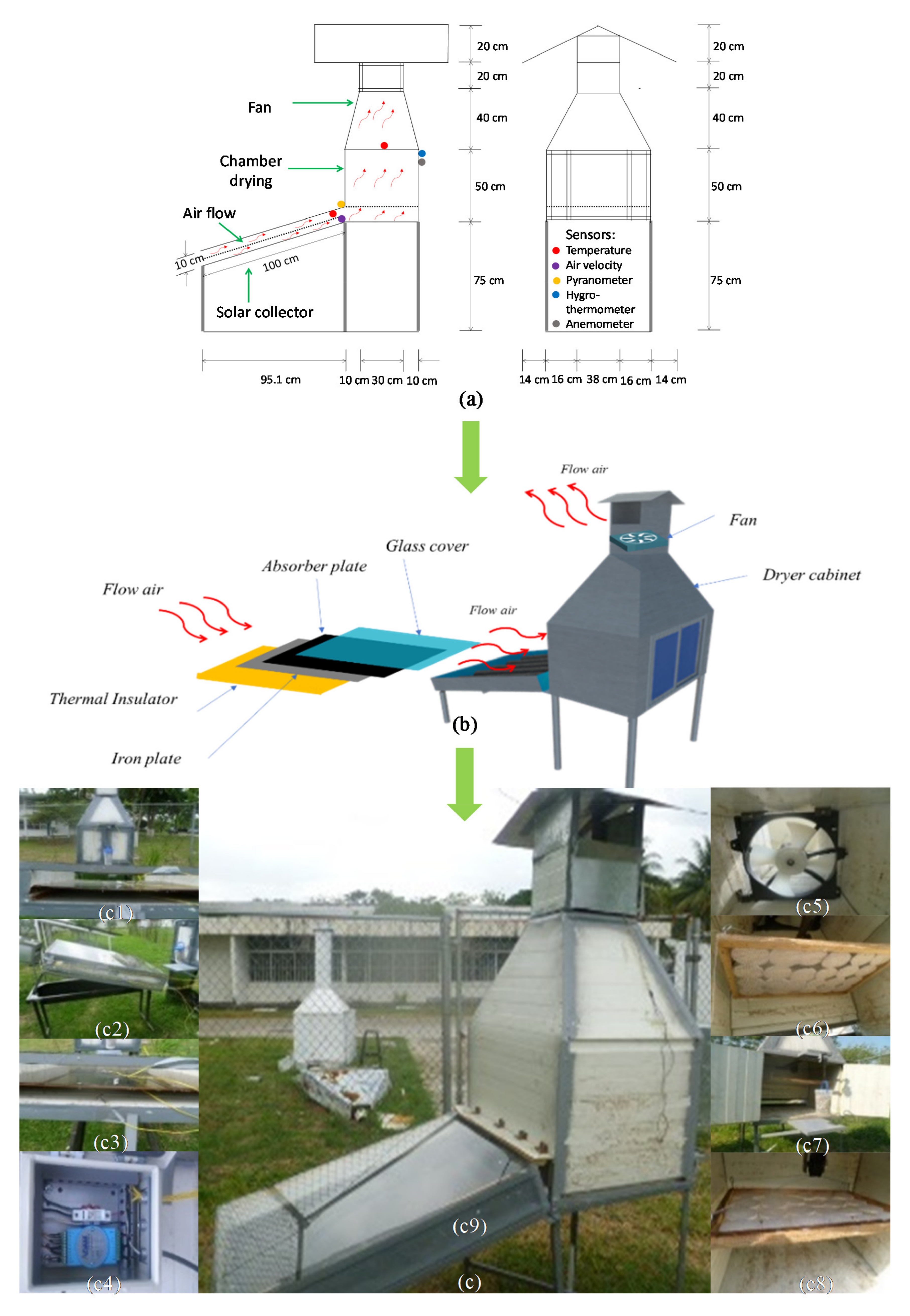

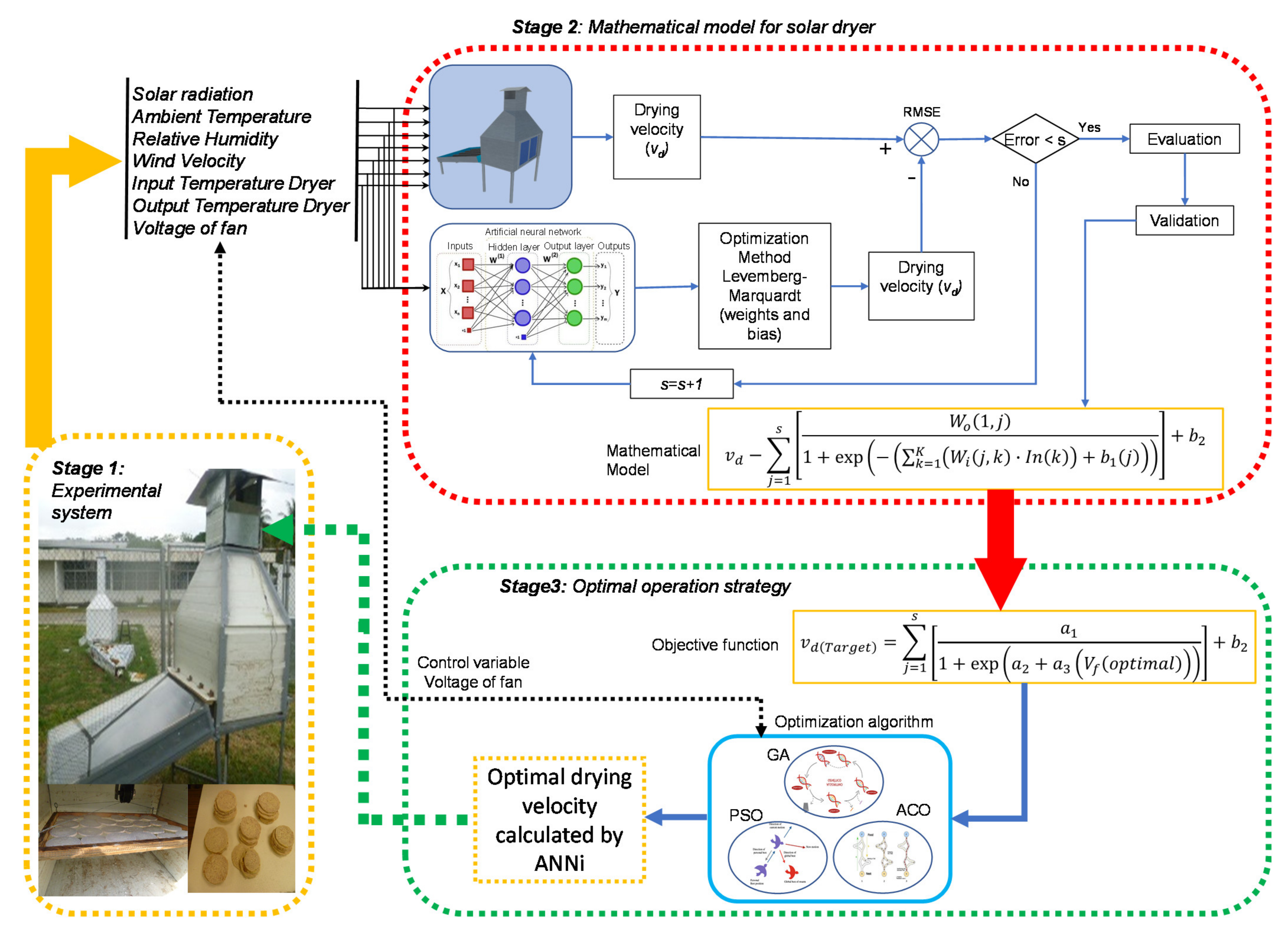
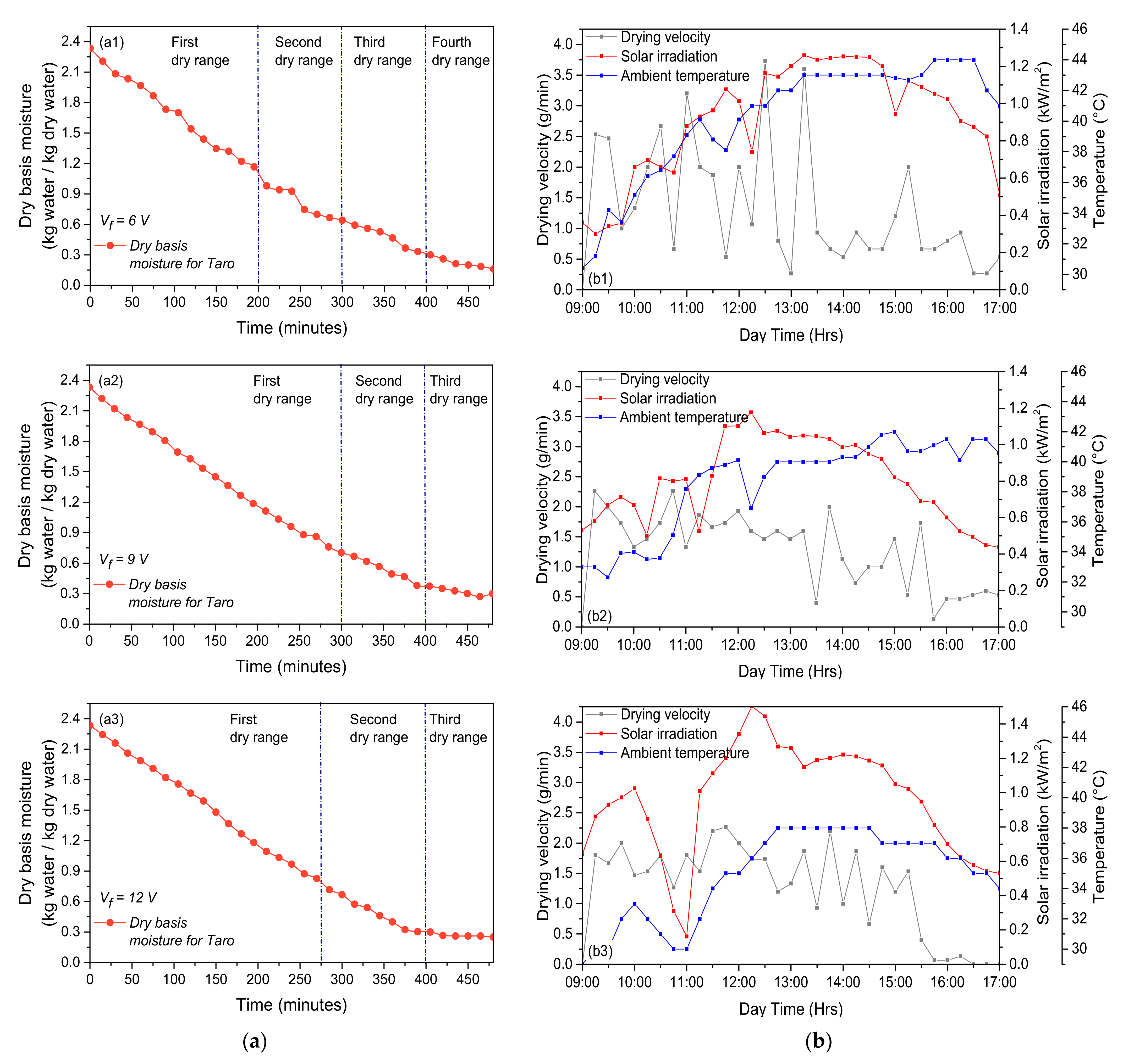

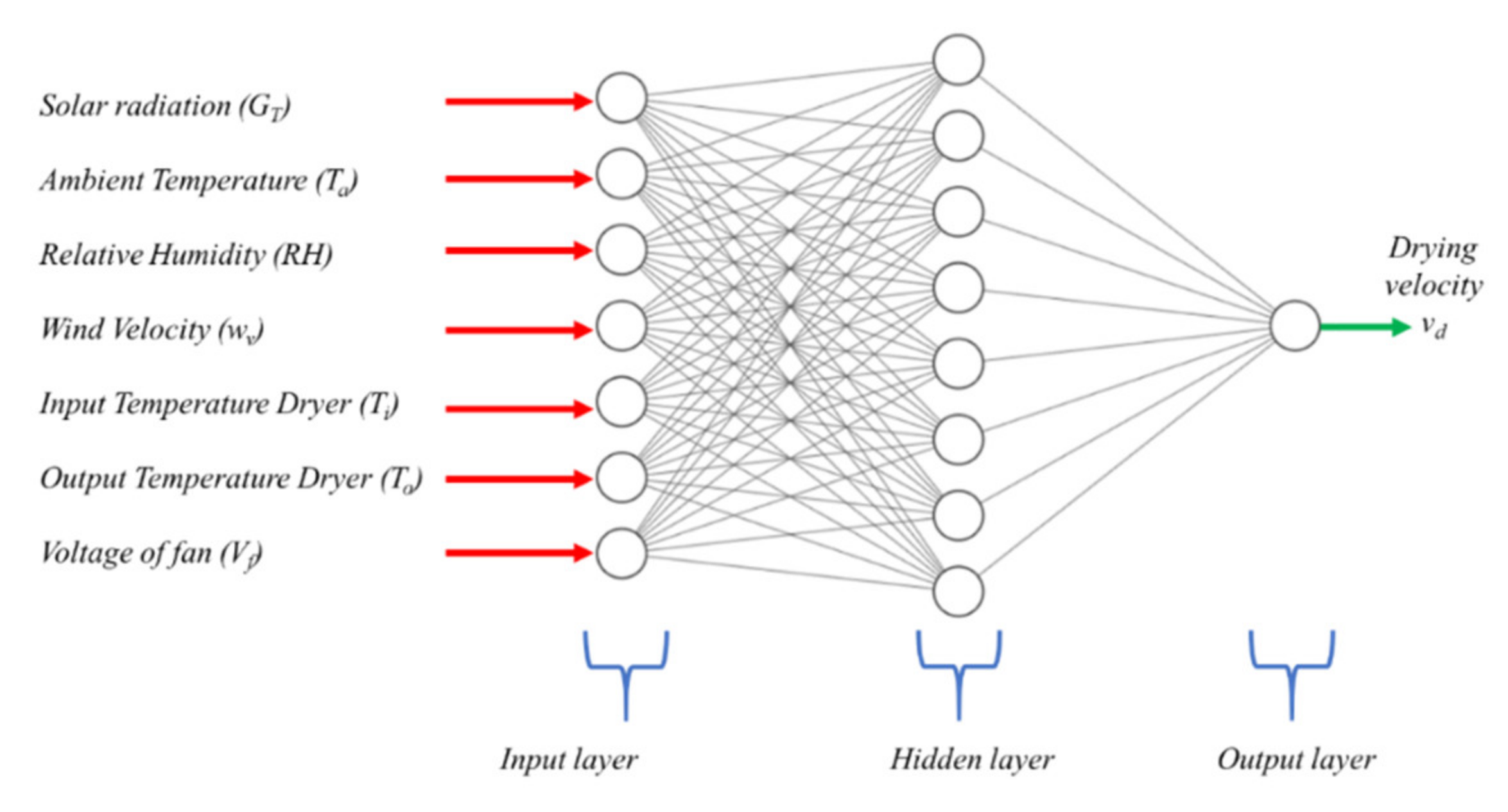
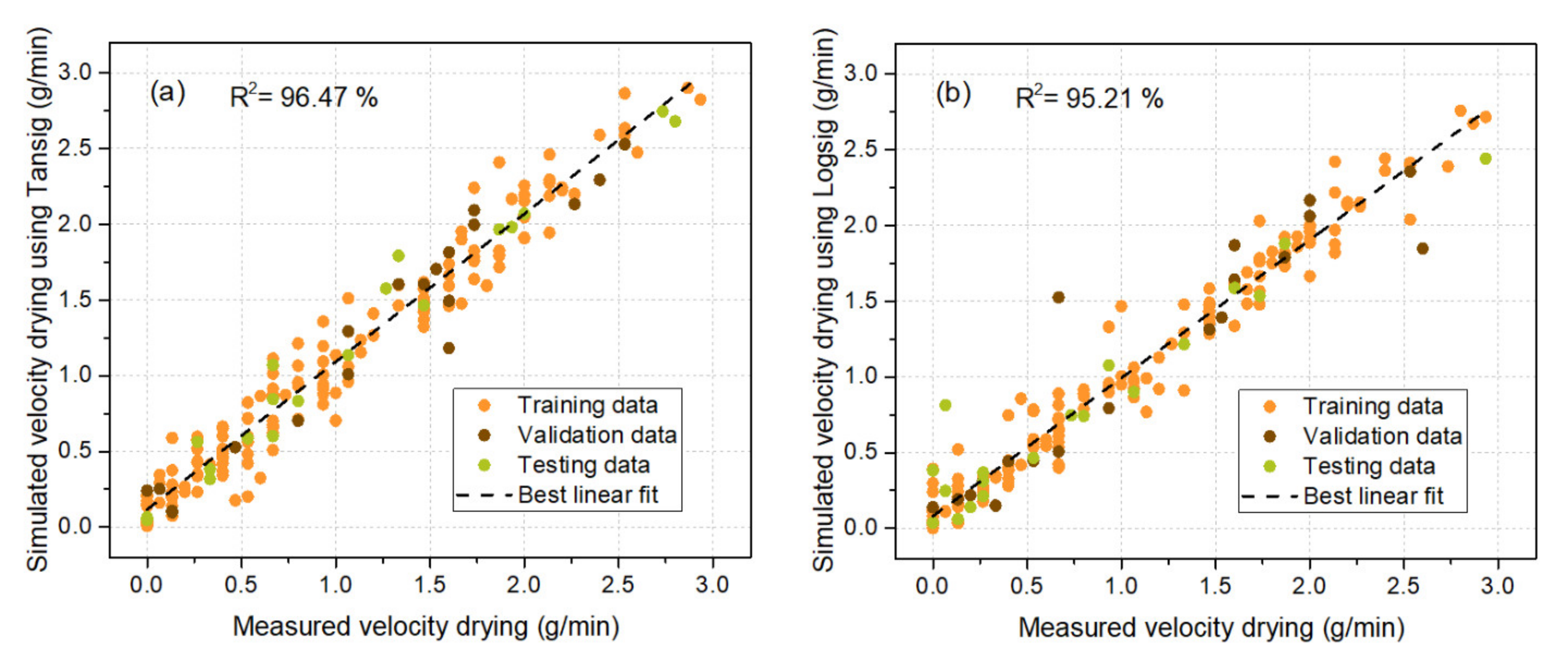
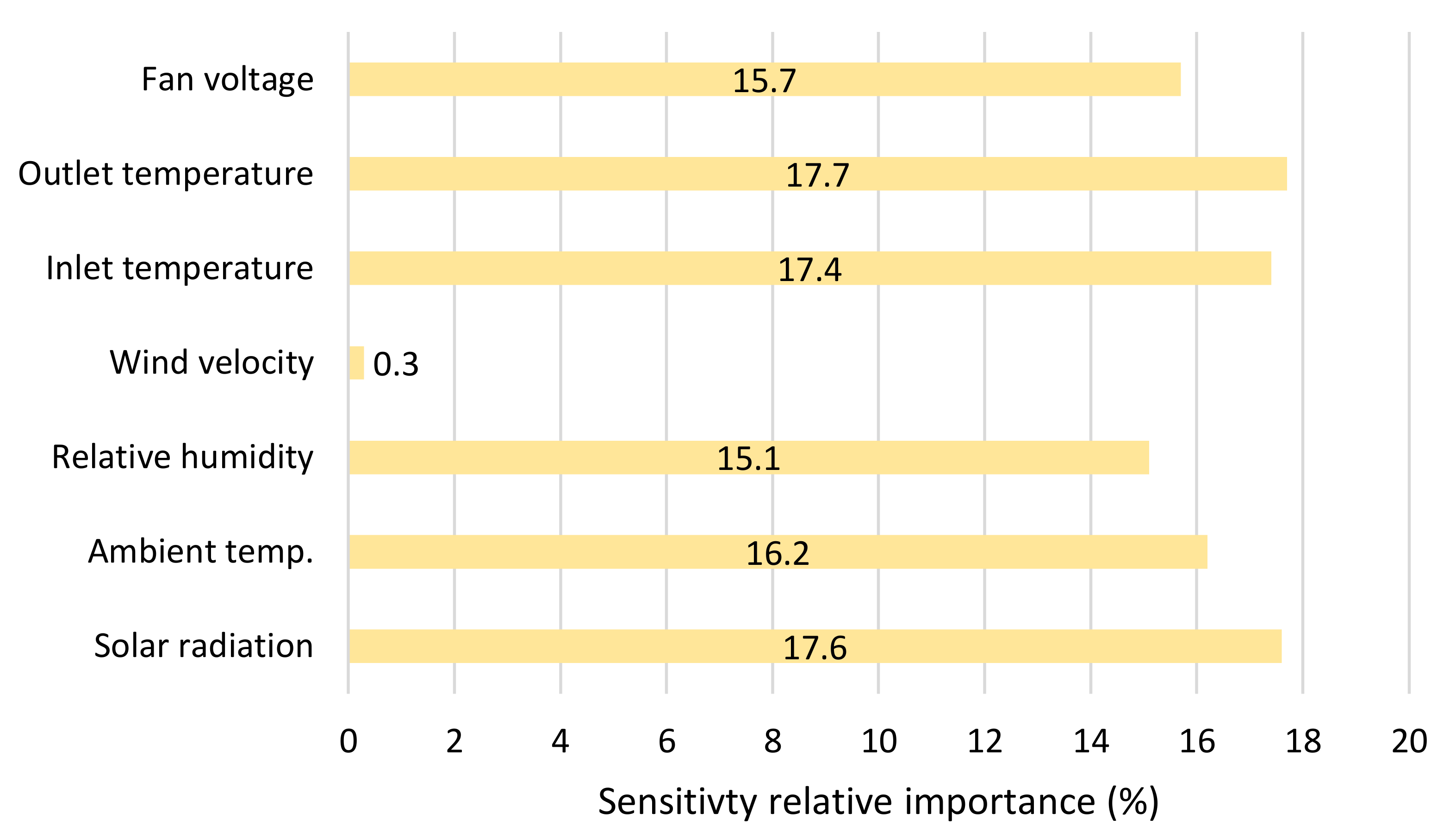
| Study | Research Scope | Artificial Intelligence and Analysis Type | Analysis Variables | Forced Ventilation | Parameters | Results |
|---|---|---|---|---|---|---|
| (Jain et al., 2015) [23] | Modelling/simulation | None/inferential Economic | Drying time | X | Drying product: herbs Special Material: phase change. ΔT = 6 °C | Economic performance was obtained with a return on equity and a simple payback period of 0.65 and 1.57 years, respectively |
| (Misha et al., 2015) [24] | Experimental/ Efficiency calculation | None/Inferential | Drying time Drying efficiency | ✓ | Drying product: kenaf Drying time: 15.75 h | Drying efficiency: 12% (0.394 kW/m2) Energy efficiency: 44% Final moisture content: below 18% Total time: 2 days |
| (Ramos et al., 2015) [25] | Modelling/ Numerical simulation | None/Inferential | Drying time | X | Drying product: grapes Model used: simultaneous model of product shrinkage Analysis performed: -Changes in effective moisture content diffusivity -The dependence of thermal properties on water content and temperature. Numerical solution: explicit finite differences | Mathematical model Simulation of the system behavior Numerical solution of the Heat and mass transfer models |
| (Fudholi et al., 2015) [22] | Experimental/ Numerical operation | None/Inferential | Drying efficiency Pick-up efficiency Exergetic Efficiency | ✓ | Drying product: oil palm leaves. Drying time: 3 days Average solar radiation: 0.6 kW/m2. Airflow velocity: 0.13 kg/s | Collector efficiency: 31% Drying system efficiency 19% Pick-up efficiency: 67% Specific moisture extraction rate (SMER): 0.29 kg/kWh Average exergetic efficiency: 47% |
| (Blanco-Cano et al., 2016) [19] | Experimental modelling/ Prediction | None/Identification | Drying time | ✓ | Drying product: Granny Smith apples. Analysis performed: -Kinetics of thin layer drying by thermogravimetry -Drying at constant temperatures ranging between 20 °C and 50 °C, with intervals of 5 °C | The experimental drying curves were fitted to the Wang–Singh equation. The model was experimentally validated with maximum deviations for drying time less than 1.5% and a prediction error of 10%. |
| (Sekyere et al., 2016) [20] | Experimental modelling/ Efficiency calculations | None/Inferential | Drying time Pick-up efficiency | X | In this research, a natural ventilation mixed pineapple solar dryer was evaluated for four drying scenarios according to specific drying periods for four typical seasons in Ghana | Moisture content decreased by 924% at 106%/h in 19 h, 1049% at 184%/h in 10 h, 912% at 155%/h in 7 h, and 1049% at 144%/h (db) in 23 h, with an efficiency of 27%, 24%, 11%, and 32% for drying in Scenarios 1, 2, 3 and 4, respectively |
| (Essalhi et al., 2017) [26] | Experimental/ Prediction | None/Inferential | Drying efficiency Drying time | X | This article presented the incorporation of two corrugated plates, forming a cylindrical structure in the absorber plate of the solar collector in a pear dryer | The mass of the samples was reduced from 997.3 g to 135.13 g in 24 h; the average thermal efficiency of the drying chamber was 11.11% |
| (Lingayat et al., 2017) [27] | Calculation | None/Inferential | Drying efficiency | X | In this study, an indirect solar dryer for plantain was designed and developed; its moisture content decreased from an initial value of 356% (db) to a final moisture content of 16.3292%, 19.4736%, 21.1592%, 31.1582%, and 42.3748% (db) for Tray 1, Tray 2, Tray 3, Tray 4, and open sun drying, respectively | The average thermal efficiency of the collector was 31.50% and that of the drying chamber was 22.38% |
| (Atalay et al., 2017) [28] | Modelling/prediction | None/inferential | Drying time | ✓ | In this study, a solar air heater was developed to determine the drying time of apples; it is a continuous dryer with packed bed thermal energy storage; a waste heat recovery unit was used | A mathematical model was developed to calculate the prediction of the humidity ratio over time |
| (Zoukit et al., 2018) [21] | Modelling/ prediction | Diffused: Takagi–Sugeno/inferential | Drying chamber outlet temperature | ✓ | In this article, a Takagi–Sugeno diffuse model is used to predict the temperature inside the dryer for any time of year in natural or forced convection | The prediction errors (RMSE%) were below 0.4 °C (0.81%) in natural convection and 0.52 °C (1.94%) in forced convection |
| (Chandrasekar et al., 2018) [29] | Experimental/ Prediction | None/inferential | Drying time | ✓ | This work treated indirect solar dryers for grapes, using the air conditioning condensing unit | This system reduced drying time by 16.7% compared to the open sun drying method; the possibility of a 13% increase in the efficiency of the solar dryer was demonstrated |
| (Simo-Tagne et al., 2019) [30] | Modelling/ Simulation | None | Temperature and relative humidity of the drying air at different points inside the dryer | X | In this research, a model for a mixed solar dryer with natural ventilation of red chili peppers was developed; the thermophysical properties of the drying air and the dried red chili were considered | The heat and mass transfer equations were solved numerically by the fourth-order Runge–Kutha method; the temperature, relative humidity of the drying air, and the dried product’s humidity profile were simulated and compared with experimental data |
| (Ekka et al., 2020) [31] | Experimental/ Prediction | None | Drying time Drying efficiency | ✓ | This article evaluated a mixed horizontal dryer with forced ventilation for black ginger with two air mass flow rates: one constant of 0.062 kg/s and another with two successive air mass flows of 0.062 kg/s during the initial drying period and 0.018 kg/s during the downshift period | The following were determined: drying time, drying efficiency, specific energy consumption (SEC), and moisture diffusivity; the estimated SECs for both cases were 1.07 kWh/kg and 0.56 kWh/kg |
| (Lingayat et al., 2020) [32] | Experimental/ Prediction | None | Drying efficiency | X | In this experimental study, an indirect solar dryer for apples and watermelons was presented; the average thermal efficiency of the collector and dryer was 54.5% and 25.39% for apples and 56.3% and 28.76% for watermelons | Moisture contents decreased from 6.16 to 0.799 kg/kg (db) for apples and from 10.76 to 0.496 kg/kg (db) for watermelons. The drying curve was adjusted with different existing models. |
| (Sekyere et al., 2020) [33] | Modelling/ Simulation | None/energy balance | Temperature | X | This article presented the modeling and validation of an experimental mixed mode natural convection solar crop dryer for three inlet openings selected for the purpose of this study | |
| In the Present Study | Modeling and experimental/prediction optimization | Neural network inverse/inferential, optimal operating conditions, and sensitivity | Drying velocity | ✓ | An experimental study of a solar dryer for plantain and taro is presented to establish the optimal operating conditions during drying in this work | An artificial neural network inverse was used, and three metaheuristic optimization strategies were evaluated: genetic algorithm, particle swarm optimization, and ant colony optimization, to maximize the drying velocity of the process |
| Type | Parameter | Symbol | Unit | Sensor | Range | Accuracy | Resolution |
|---|---|---|---|---|---|---|---|
| Environmental | Solar irradiance | GT | W·m−2 | Solar energy meter Amprobe Solar 100 | 0–1999 W·m−2 | ±10 W·m−2 | 0.1 W·m−2 |
| Room temperature | Ta | °C | Hygro-Thermometer Extech RH101 | −20–60 °C | ±2 °C | 0.1 °C | |
| Relative Humidity | RH | % | 10–95% | ±3.5% | 0.1% | ||
| Wind velocity | wv | m/s | Fin anemometer Extech 451126 | 0.30–45.00 m/s | ± (3% + 0.1 m/s) | 0.01 m/s | |
| Operational | Inlet temperature in the drying chamber | Ti | °C | Thermocouple K type | 0–400 °C | ±2.2 °C | 0.1 °C |
| Drying chamber outlet temperature | To | °C | |||||
| Air velocity at the inlet of the drying chamber | vid | m/s | Fin anemometer Extech 451126 | 0.30–45.00 m/s | ± (3% + 0.1 m/s) | 0.01 m/s | |
| Product mass | mp | kg | Weighing scales Torrey L-PCR 20 | 0–20 kg | ±0.005 kg | 0.001 kg |
| Experimental Variables | Working Range | Unit |
|---|---|---|
| Inputs | ||
| Solar radiation | 143–1222 | W·m−2 |
| Ambient temperature | 27–44 | °C |
| Relative humidity | 24.6–95.7 | % |
| Wind velocity | 0–2.6 | m/s |
| Input temperature dryer | 31.5–49.7 | °C |
| Output temperature dryer | 17–48 | °C |
| Voltage of fan | 6, 9, 12 | V |
| Output | ||
| Drying velocity | 0–6.4 | g/min |
| Statistical Parameter | Mathematical Expression |
|---|---|
| Root-mean-square error | |
| Mean absolute percentage error | |
| Determination coefficient | |
| Linear regression coefficient |
| Function | Architecture ANN | RMSE | R2 | R | MAPE (%) | Regression Line Equation |
|---|---|---|---|---|---|---|
| Hyperbolic tangent | 7–2–1 | 0.3215 | 0.9052 | 0.9514 | 60.1 | |
| 7–4–1 | 0.2611 | 0.9174 | 0.9578 | 37.0 | ||
| 7–6–1 | 0.2331 | 0.9384 | 0.9687 | 44.1 | 0.0955 | |
| 7–8–1 | 0.1912 | 0.9647 | 0.9822 | 31.9 | 0.1000 | |
| 7–10–1 | 0.1718 | 0.9672 | 0.9835 | 31.5 | ||
| Logistic sigmoid | 7–2–1 | 0.3096 | 0.8896 | 0.9432 | 49.6 | 0.1417 |
| 7–4–1 | 0.3377 | 0.8802 | 0.9382 | 52.6 | 0.0665 | |
| 7–6–1 | 0.3020 | 0.9111 | 0.9545 | 45.8 | ||
| 7–8–1 | 0.2139 | 0.9521 | 0.9757 | 25.4 | ||
| 7–10–1 | 0.2467 | 0.9430 | 0.9711 | 37.4 |
| Number of Neurons (s) a | Weights | Bias | ||||||||
|---|---|---|---|---|---|---|---|---|---|---|
| Hidden Layer (s = 8, k = 7) IW (s,k) | Output Layer (l = 1) LW (s,1) | |||||||||
| GT (k = 1) | Ta (k = 2) | RH (k = 3) | wv (k = 4) | Ti (k = 5) | To (k = 6) | Vf (k = 7) | vd (s, l) | b1(s) | b2(l) | |
| 1 | −1.657 | −2.9817 | −2.7513 | 2.5193 | 14.1473 | −5.7701 | 5.5048 | −0.9467 | −4.2106 | −0.6046 |
| 2 | −4.2833 | −8.6675 | −3.1531 | 2.8148 | 8.0529 | −4.7781 | 3.778 | 0.2534 | 7.0302 | |
| 3 | −5.4441 | 5.1909 | 5.2031 | −1.229 | 8.7126 | 0.7922 | 5.2029 | 0.4303 | −10.0586 | |
| 4 | 3.8771 | 3.3046 | 1.0957 | −4.0755 | 2.0218 | −5.9647 | 8.0048 | 0.8152 | −9.7295 | |
| 5 | −5.1569 | 5.2198 | 5.9442 | −0.798 | −8.2684 | 0.7867 | 5.2382 | 0.7854 | 0.5342 | |
| 6 | 3.9835 | 0.019 | 4.3298 | −4.736 | 5.233 | 4.323 | 3.2496 | 0.3684 | −15.1834 | |
| 7 | 3.4842 | −3.6018 | 4.2551 | 4.0861 | 12.6289 | 0.0656 | −2.6615 | −0.0366 | −14.5054 | |
| 8 | −5.6277 | −1.8747 | 3.4161 | −1.137 | 12.6587 | 2.5455 | −3.6899 | 0.025 | −2.1126 | |
| Experimental Data | ANNi-GA | ANNi-PSO | ANNi-ACO | |||||||||
|---|---|---|---|---|---|---|---|---|---|---|---|---|
| Vf (V) | Vf (V) | Vf (V) | ||||||||||
| vd (g/min) | Vf (V) | Optimal | Computing Time (s) | Optimal | Computing Time (s) | Optimal | Computing Time (s) | |||||
| Taro | 1 | 0.0667 | 6 | 5.90 | 1.67 | 3.4 | 6.20 | 3.33 | 3.3 | 5.70 | 5.00 | 4.0 |
| 2 | 0.9333 | 6 | 6.17 | 2.83 | 3.7 | 5.75 | 4.17 | 8.1 | 6.20 | 3.33 | 7.2 | |
| 3 | 1.9333 | 6 | 6.05 | 0.83 | 4.3 | 6.15 | 2.50 | 8.6 | 6.40 | 6.67 | 10.5 | |
| 4 | 2.9333 | 6 | 5.83 | 2.83 | 4.5 | 6.28 | 4.67 | 10.2 | 5.75 | 4.17 | 10.6 | |
| 5 | 0.1333 | 9 | 9.3 | 3.33 | 5.5 | 9.35 | 3.89 | 11.4 | 9.4 | 4.44 | 11.5 | |
| 6 | 0.7333 | 9 | 9.2 | 2.22 | 4.3 | 9.5 | 5.56 | 8.3 | 9.3 | 3.33 | 13.7 | |
| 7 | 1.8667 | 9 | 8.9 | 1.11 | 3.7 | 8.7 | 3.33 | 7.2 | 8.48 | 5.78 | 14.2 | |
| 8 | 2.2667 | 9 | 8.78 | 2.44 | 3.0 | 8.9 | 1.11 | 8.7 | 8.7 | 3.33 | 12.0 | |
| 9 | 0.1333 | 12 | 11.83 | 1.42 | 3.2 | 11.8 | 1.67 | 6.8 | 11.64 | 3.00 | 9.2 | |
| 10 | 1.0667 | 12 | 11.77 | 1.92 | 3.5 | 12.4 | 3.33 | 9.5 | 11.45 | 4.58 | 12.1 | |
| Plantain | 1 | 1.8667 | 12 | 12.5 | 4.17 | 4.4 | 12.5 | 4.17 | 8.5 | 12.5 | 4.17 | 12.0 |
| 2 | 2.9333 | 12 | 12.4 | 3.33 | 4.3 | 11.45 | 4.58 | 5.2 | 12.3 | 2.50 | 10.4 | |
| 3 | 0.0667 | 6 | 6.20 | 3.33 | 4.9 | 6.30 | 5.00 | 4.1 | 5.70 | 5.00 | 4.1 | |
| 4 | 0.9333 | 6 | 5.70 | 5.00 | 5.8 | 6.20 | 3.33 | 4.7 | 6.27 | 4.50 | 5.1 | |
| 5 | 1.9333 | 6 | 5.68 | 5.33 | 5.3 | 5.83 | 2.83 | 8.2 | 6.15 | 2.50 | 5.2 | |
| 6 | 2.9333 | 6 | 6.15 | 2.50 | 4.4 | 5.74 | 4.33 | 9.7 | 6.20 | 3.33 | 9.6 | |
| 7 | 0.1333 | 9 | 9.4 | 4.44 | 3.8 | 8.9 | 1.11 | 11.3 | 8.7 | 3.33 | 11.0 | |
| 8 | 0.7333 | 9 | 8.7 | 3.33 | 3.8 | 8.73 | 3.00 | 14.8 | 9.4 | 4.44 | 15.7 | |
| 9 | 1.8667 | 9 | 8.81 | 2.11 | 4.4 | 9.4 | 4.44 | 16.7 | 8.9 | 1.11 | 19.0 | |
| 10 | 2.2667 | 9 | 9.23 | 2.56 | 4.5 | 8.68 | 3.56 | 11.8 | 8.56 | 4.89 | 17.4 | |
Publisher’s Note: MDPI stays neutral with regard to jurisdictional claims in published maps and institutional affiliations. |
© 2021 by the authors. Licensee MDPI, Basel, Switzerland. This article is an open access article distributed under the terms and conditions of the Creative Commons Attribution (CC BY) license (https://creativecommons.org/licenses/by/4.0/).
Share and Cite
Moheno-Barrueta, M.; Tzuc, O.M.; Martínez-Pereyra, G.; Cardoso-Fernández, V.; Rojas-Blanco, L.; Ramírez-Morales, E.; Pérez-Hernández, G.; Bassam, A. Experimental Evaluation and Theoretical Optimization of an Indirect Solar Dryer with Forced Ventilation under Tropical Climate by an Inverse Artificial Neural Network. Appl. Sci. 2021, 11, 7616. https://doi.org/10.3390/app11167616
Moheno-Barrueta M, Tzuc OM, Martínez-Pereyra G, Cardoso-Fernández V, Rojas-Blanco L, Ramírez-Morales E, Pérez-Hernández G, Bassam A. Experimental Evaluation and Theoretical Optimization of an Indirect Solar Dryer with Forced Ventilation under Tropical Climate by an Inverse Artificial Neural Network. Applied Sciences. 2021; 11(16):7616. https://doi.org/10.3390/app11167616
Chicago/Turabian StyleMoheno-Barrueta, M., O. May Tzuc, G. Martínez-Pereyra, V. Cardoso-Fernández, L. Rojas-Blanco, E. Ramírez-Morales, G. Pérez-Hernández, and A. Bassam. 2021. "Experimental Evaluation and Theoretical Optimization of an Indirect Solar Dryer with Forced Ventilation under Tropical Climate by an Inverse Artificial Neural Network" Applied Sciences 11, no. 16: 7616. https://doi.org/10.3390/app11167616








